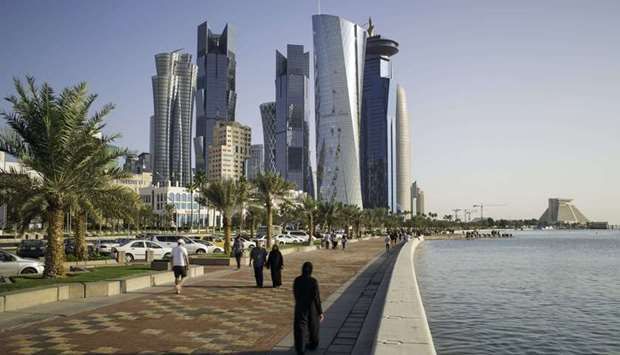Qatar's hydrocarbons sector and certain manufacturing businesses such as basic chemicals and refined petroleum products faced significant price pressure this October, as the country's producers' price index (PPI) soared 103% year-on-year, according to the official estimates.
Qatar's PPI, which captures price pressure felt by the producers of goods and services, shot up 13.5% on a monthly basis in the review period, said the figures released by the Planning and Statistics Authority (PSA).
The PSA had released a new PPI series in late 2015. With a base of 2013, it draws on an updated sampling frame and new weights. The previous sampling frame dates from 2006, when the Qatari economy was much smaller than today and the range of products made domestically much narrower.
The hardening of the global crude oil and industrial input prices had its reflection in the PPI.
The mining PPI, which carries the maximum weight of 72.7%, reported 122.2% surge year-on-year in October 2021 as the selling price of crude petroleum and natural gas was seen soaring 122.8%; even as that of stone, sand and clay declined 1.9%.
The mining PPI escalated 16.3% on a monthly basis in October this year on the back of a 16.3% jump in the average selling price of crude petroleum and natural gas and 0.9% in stone, sand and clay.
The manufacturing sector PPI, which has a weight of 26.8% in the basket, zoomed 70% year-on-year in October 2021 on the back of a 110.9% increase in the average price of basic chemicals, 73% in refined petroleum products, 35.1% in basic metals, 13.3% in rubber and plastics products, 11.4% in paper and paper products, 6.2% in other chemical products and fibres, 0.7% in cement and other non-metallic mineral products and 0.6% in grain mill and other products.
Nevertheless, there was 1.2% decline in the average selling price of juices and 1.1% in beverages.
The manufacturing sector PPI had seen a monthly 7.9% expansion this October as the average selling price of refined petroleum products grew 9.2%, basic chemicals (7.7%), basic metals (2.9%), rubber and plastics products (2.6%), cement and other non-metallic mineral products (2.1%) and grain mill and other products (0.9%).
However, there was 1.6% shrinkage in the average selling price of beverages, 0.6% in dairy products and 0.4% in other chemical products and fibres.
The utilities group, which has a mere 0.5% weightage in the PPI basket, saw its index soar 8% year-on-year because of a 13.6% increase in the average selling price of water and 2.6% in electricity in October 2021.
The index had seen a 3.5% growth month-on-month this October as the average selling price of water and electricity was seen rising 4.6% and 2.4% respectively.
Qatar's PPI, which captures price pressure felt by the producers of goods and services, shot up 13.5% on a monthly basis in the review period, said the figures released by the Planning and Statistics Authority (PSA).
The PSA had released a new PPI series in late 2015. With a base of 2013, it draws on an updated sampling frame and new weights. The previous sampling frame dates from 2006, when the Qatari economy was much smaller than today and the range of products made domestically much narrower.
The hardening of the global crude oil and industrial input prices had its reflection in the PPI.
The mining PPI, which carries the maximum weight of 72.7%, reported 122.2% surge year-on-year in October 2021 as the selling price of crude petroleum and natural gas was seen soaring 122.8%; even as that of stone, sand and clay declined 1.9%.
The mining PPI escalated 16.3% on a monthly basis in October this year on the back of a 16.3% jump in the average selling price of crude petroleum and natural gas and 0.9% in stone, sand and clay.
The manufacturing sector PPI, which has a weight of 26.8% in the basket, zoomed 70% year-on-year in October 2021 on the back of a 110.9% increase in the average price of basic chemicals, 73% in refined petroleum products, 35.1% in basic metals, 13.3% in rubber and plastics products, 11.4% in paper and paper products, 6.2% in other chemical products and fibres, 0.7% in cement and other non-metallic mineral products and 0.6% in grain mill and other products.
Nevertheless, there was 1.2% decline in the average selling price of juices and 1.1% in beverages.
The manufacturing sector PPI had seen a monthly 7.9% expansion this October as the average selling price of refined petroleum products grew 9.2%, basic chemicals (7.7%), basic metals (2.9%), rubber and plastics products (2.6%), cement and other non-metallic mineral products (2.1%) and grain mill and other products (0.9%).
However, there was 1.6% shrinkage in the average selling price of beverages, 0.6% in dairy products and 0.4% in other chemical products and fibres.
The utilities group, which has a mere 0.5% weightage in the PPI basket, saw its index soar 8% year-on-year because of a 13.6% increase in the average selling price of water and 2.6% in electricity in October 2021.
The index had seen a 3.5% growth month-on-month this October as the average selling price of water and electricity was seen rising 4.6% and 2.4% respectively.


